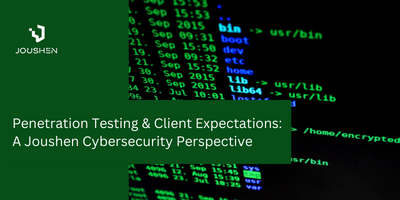Penetration Testing & Client Expectations: A Joushen Cybersecurity Perspective
Penetration testing (pentesting) is a critical part of any organization’s cybersecurity strategy. It helps to identify and remediate vulnerabilities before they can be exploited by attackers. However, client expectations can vary when it comes to pentesting.
What clients expect from a pentest?
Some of the most common client expectations for pentesting include:
- An easy-to-read and understand report. The report should be specific to the in-scope domain and should provide clear and actionable recommendations for remediating the vulnerabilities that were found.
- No or minimal false positives. False positives can be costly and time-consuming to investigate, so clients expect pentesters to use their skills and experience to minimize false positives.
- A secure application after the pentest. The ultimate goal of pentesting is to improve the security of the application being tested. Clients expect pentesters to help them identify and fix all of the vulnerabilities that were found during the pentest.
How to meet client expectations?
At Joushen Cybersecurity, we understand the importance of meeting and exceeding client expectations for pentesting. Here are a few tips:
- Communicate with the client early and often. Before the pentest begins, meet with the client to discuss their specific goals and expectations. This will help to ensure that everyone is on the same page and that the pentest is tailored to the client’s needs.
- Use a variety of pentesting tools and techniques. No single pentesting tool or technique is perfect, so it is important to use a variety of approaches to get the most comprehensive results. This will help to reduce the risk of false positives and ensure that all of the potential vulnerabilities are identified.
- Document your findings carefully. The pentest report should be clear, concise, and actionable. It should include a detailed description of each vulnerability that was found, as well as a recommendation for how to remediate the vulnerability.
- Be responsive to the client’s needs after the pentest. After the pentest is complete, be available to answer any questions that the client has about the report or to help them develop a plan to remediate the vulnerabilities.
Additional tips from a pentester’s perspective
Here are a few additional tips for meeting client expectations from the perspective of a pentester:
- Ring some bells. If the client wants to see their defense system in action, generate some alerts by brute forcing, running intruders, and playing with firewalls. This will show them that their security systems are working and that they are not vulnerable to simple attacks.
- Provide proof of concept and impact. For each finding, provide the client with a proof of concept and an explanation of the impact that the vulnerability could have on their organization. This will help them to understand the importance of fixing the vulnerability.
- Teamwork is key. A successful pentesting assessment requires the cooperation of the entire team. Make sure to keep your lead and team members informed of your progress and to ask for help when you need it.
Conclusion
At Joushen Cybersecurity, we are committed to providing our clients with the highest quality pentesting services available. We understand that client expectations vary, but we are confident that we can meet or exceed those expectations on every assessment. If you are looking for a pentesting partner that can help you improve the security of your applications, we encourage you to contact us today.

